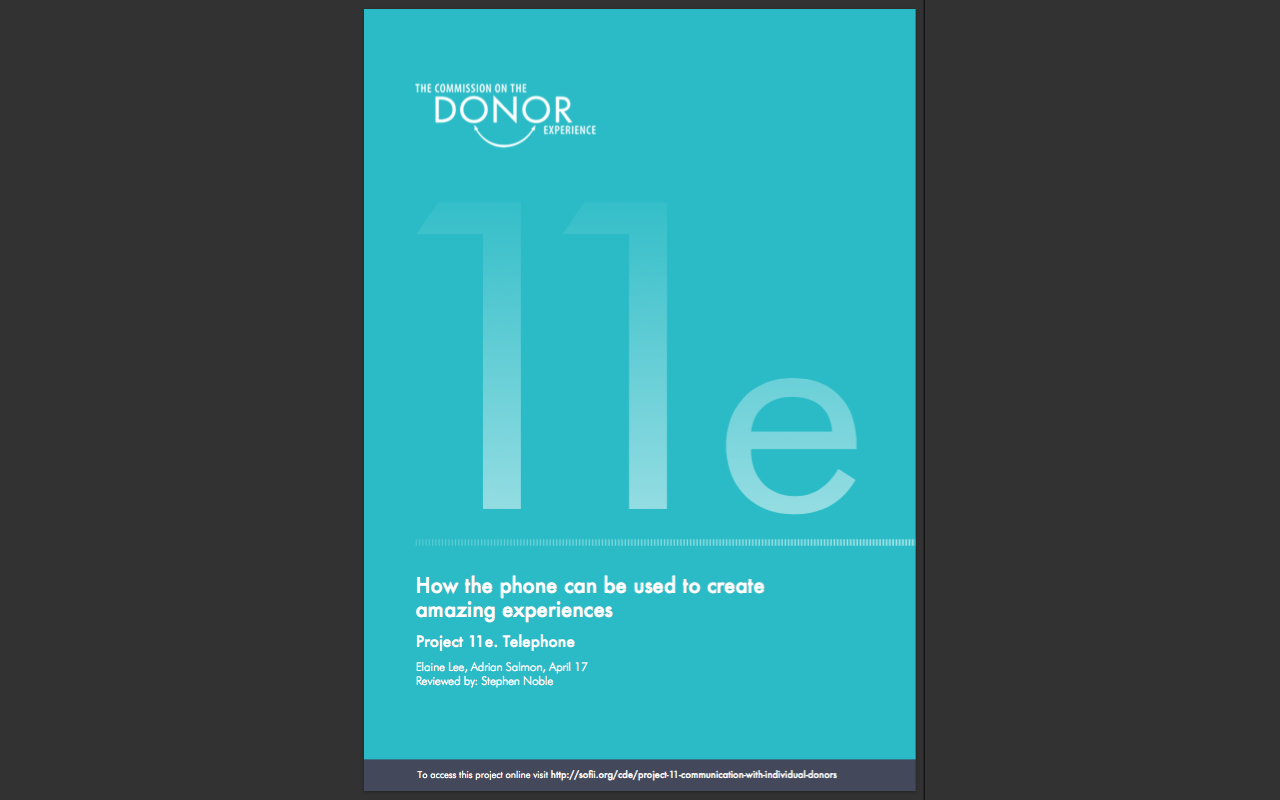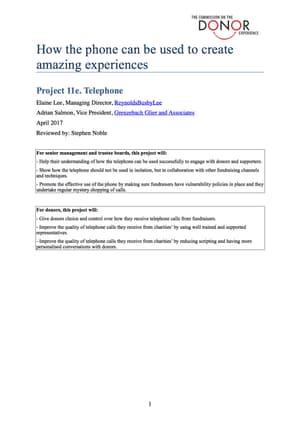CDE project 11e summary: telephone
- Written by
- The Commission on the Donor Experience
- Added
- April 25, 2017
How the phone can be used to create amazing experiences
Elaine Lee, Adrian Salmon April 2017
Reviewed by: Stephen Noble


Summary Principles
The telephone is a powerful and engaging channel of communication to reach donors and supporters when it is used within a multi-channel communication strategy. The telephone should be used to engage with donors and supporters to build true relationships and should not be solely used as a fundraising channel in isolation.
When considering telephone activity consideration should be given to all steps outlined below. Activity undertaken on the telephone must;
- Be collaborative and run in partnership - trustees, Chief Executives, senior managers, fundraisers and agencies (if used) must have shared objectives and an agreed plan for delivering those objectives. Take time to develop and agree the objectives and truly understand how they can be implemented and delivered upon at a detailed level. Challenge anything that doesn’t ‘fit’ or conflicts with another objective and don’t give up.
- Be evaluated by a wider range of metrics than year one return on investment and take a long-term view – focus on more than just financial metrics as measures of success. Since the strength of the phone is often most seen in delivering long-term income via Direct Debit, year one metrics are rarely appropriate for measuring its success and can lead to poor decision making. Donor satisfaction, quality of conversations, retained permission for future contact and attrition can and should also be used to measure success. Review campaigns from previous years and look at the development of those donors over time. Campaigns should be an element of the donor journey and do not happen in isolation – look at results and outcomes beyond the specific campaign results. See CDE project 3 – Satisfaction and commitment.
- Think ‘case study’ – plan, analyse and review each activity as though you intend to make a case study to share best practice. Question what have you learned from the activity and what could you do better to deliver the objectives and requirements of the donors and the organisation. You can then share and learn from others too.
- Be respectful, - conducted with consent from donors, and conducted at times that are welcomed by the donors. Consider your audience and, if possible, when they believe it would be appropriate to be called on the days of the week and calling hours planned. Use the opportunity to retain consent for continued contact across the multi-channel communication strategy.
- Give donors choice and control – allow donors choice and control in how their relationship works, consent calls are a perfect example of asking donors what they want to hear about and when – from this information charities can determine a donor journey that is relevant, timely and personalised to each donor. Consider using more ‘open’ or ‘range’ ask approaches rather than the traditional 3-ask negotiation approach to give the donor choice and control in the level of their donations. See CDE project 13 – Giving donors choices and managing preferences. For example, an ‘open’ ask would simply be ‘How much would you like to give towards this work?’ while a ‘range’ ask would be, ‘People we’re speaking to are generally giving between £5 and £15 towards this project, what would suit you?’, or, ‘Would you like to give £10, £30, or £50 tonight?’
- Utilise information effectively – capture, store and utilise donor motives for getting involved with a charity. This information should then be used to guide all subsequent conversations across all channels. Telephone calls can be used to establish how donors wish to be contacted and which ‘products’ are most relevant to them. The information can then be used to personalise the relationship with timely and relevant contacts.
- Recognise that charities must balance their duty of care to beneficiaries to ask, against supporters’ and potential supporters’ right to say “no”. Donors should never feel unduly pressurised to receive telephone fundraising calls, or to comply with any requests made of them. They should have a clear understanding of why they were asked, and always end the conversation feeling valued and in control.
- Be properly resourced – whether using an agency, or run in-house, sufficient budget and staff resources should be allocated to the telephone to ensure a quality experience for donors. In particular, agency partners should never be chosen on price alone, but on a range of quality indicators. See CDE project 21 – Working with suppliers as partners.
- Have well trained and supported representatives making calls – telephone calls are truly acting as the ‘voice of a charity’ and therefore a true investment must be made to ensure that the callers have a positive environment and experience when making calls. They should be well trained, briefed and supported in their work and should be paid above the minimum wage.
- Be transparent – state your purpose of the call clearly and in full at the beginning of the call. Provide clear signposting throughout as to what will happen next and the options available to the supporter. Don’t try and disguise fundraising as something else. This is in line with the Fundraising Regulator ‘Code of Fundraising Practice’, section 8.3.1.
- Be engaging – telephone calls should involve a dialogue not a monologue. Plan the conversations and identify opportunities to encourage donors to get involved. Lead donors to value, not fear, the calls. Calls should invite involvement from donors and supporters and should avoid replicating a direct mail pack where information is pushed to the donor. Before calling consider the experience from the donor’s perspective, if you can’t deliver a positive experience, irrespective of the outcome, don’t make the call
- Be natural and flexible – calls should not follow a set script that must be read verbatim. In order to achieve a truly engaging call fundraisers, should listen and adapt and have personalised conversations with each donor
- Humanise the experience – avoid ’robotic’ sounding scripts being read by fundraisers making the calls. Try to find the ‘joy’ in each conversation and strengthen the connection between donor and charity by delivering to meet the donors’ needs or expectations. For further information please see the Save the Children case study later in this document.
- Recognise that donors may also be service users / beneficiaries – this can be reflected in the one-to-one conversations taking place.
- Be more than just ‘an ask’ – telephone calls should deliver a true value exchange giving the donor rewards that are important to them, in order to retain commitment and engagement for the long-term. Calls purely to thank and inform donors of the impact of their gifts can give donors a pleasant surprise, given the paucity of their use across the sector. Consider running consent campaigns to clarify donor consent and use this as an opportunity to re-engage the donor to the cause and mission. Legacy calls to establish interest in and motivations for leaving Gifts in Wills can be achieved without including a financial ask. The insight gathered can be utilised to determine the stewardship path that is relevant for each donor
- Recognise potential vulnerability in both those being contacted and those planning and making the calls. The telephone does not afford any visual indicators that vulnerability may be present and therefore callers must be trained to recognise and supported in their handling of these calls. A vulnerable people’s policy which safeguards donors, beneficiaries and staff should be created and adopted. Ideally each charities policy should be publicly available. Use the guidance provided by the Institute of Fundraising to help shape your policy and seek out external help. You are not the only organisation facing this issue, so do learn from others in and outside of the sector. See CDE project 2 - Fundraising and vulnerability.
- Be effective and bring resolution – ensure that all aspects of each call are addressed including questions are raised by donors / supporters. If answers cannot be provided immediately, ensure that someone takes ownership of the outstanding items until they have been resolved
- Utilise the information and insight gathered during the conversations irrespective of the outcome of the contact. Ensure that this is contained within data files that are used for follow-up activity e.g. thank you or follow-up letters. In addition, use the insight when planning and implementing subsequent contacts across all channels employed in the communications strategy.




















